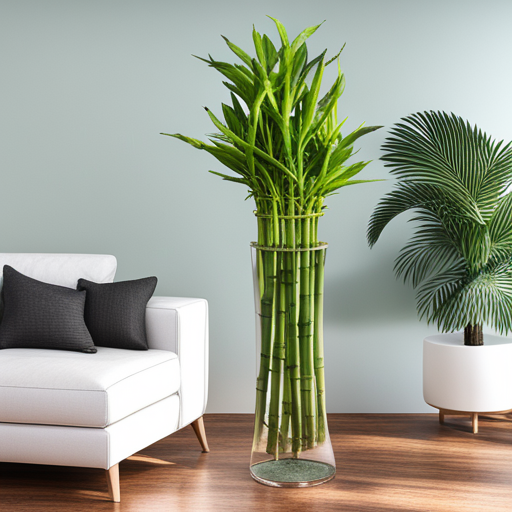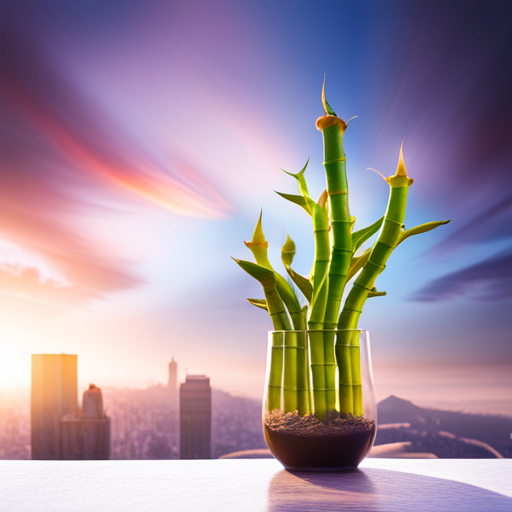Lucky bamboo, also known as Ribbon Dracaena, is a popular indoor plant that is highly valued for its attractiveness and ease of care. Believed to bring positive energy into the home or workplace according to feng shui principles, lucky bamboo belongs to the species Dracaena sanderiana and is not actually a type of bamboo.
Unlike true bamboos, lucky bamboo features fleshy stems and grows at a moderate rate. It can be cultivated in both water and soil, although it thrives best in bright yet indirect light. Commonly, lucky bamboo arrangements showcase the stalks growing in decorative pots filled with water or pebbles. When grown in water, it is recommended to change the water every one to two weeks, preferably with distilled or purified water. Alternatively, when cultivated in soil, a well-aerated potting soil with good drainage is advised, and the soil should be kept moist but not overly saturated.
Although lucky bamboo can survive without fertilizer for extended periods, occasional fertilization can stimulate growth and be beneficial if the water becomes dirty or the leaves start yellowing.
In this article, we will explore the characteristics, growth requirements, and decorative arrangements of lucky bamboo, highlighting its appeal as an attractive and low-maintenance indoor plant believed to bring positive energy into its surroundings.
Contents
Our Highlighted Points
- Lucky bamboo is a popular indoor plant that is attractive and easy to care for.
- Lucky bamboo is believed to bring positive energy into the home or workplace according to feng shui.
- Lucky bamboo is not actual bamboo, but a species of plants called Dracaena sanderiana.
– Lucky bamboo can grow in both soil and water, but it prefers bright but indirect light.
What is it?

Lucky bamboo, also known as Dracaena sanderiana, is a popular indoor plant that is attractive and easy to care for, believed to bring positive energy into the home or workplace according to feng shui.
It is not actual bamboo, but a species of plants called Dracaena. Lucky bamboo has long thin foliage, resembling ribbons, which gives it its other names, Ribbon Dracaena or Ribbon Plant.
According to feng shui, lucky bamboo is said to bring benefits such as good luck, prosperity, and positive energy into the space it inhabits. This is why it is often used as a decorative plant in homes and offices.
It is believed that the number of stalks of lucky bamboo can represent different things, such as wealth, health, and love. By incorporating lucky bamboo into the environment, individuals hope to create a harmonious and positive atmosphere.
Growth and Care

Dracaena sanderiana, a popular ornamental plant, requires specific care and attention to ensure optimal growth and development. Lucky bamboo has an average growth rate and can reach a height of up to three feet when properly cared for. Pruning techniques can be used to control the height and shape of the plant. This can be achieved by cutting the stems just above the nodes, which encourages branching and promotes a bushier growth.
Lucky bamboo is generally a low-maintenance plant, but it is susceptible to certain common pests such as spider mites and mealybugs. Regularly inspecting the plant for signs of infestation and promptly treating any issues with appropriate insecticides or natural remedies is essential to maintain the health and appearance of the plant.
Decorative Arrangements

Decorative arrangements involving the long, slender foliage of the Dracaena sanderiana plant are commonly used to enhance the aesthetic appeal of indoor spaces. These arrangements not only provide visual interest but also contribute to the positive energy believed to be associated with lucky bamboo.
Creative container ideas can further elevate the overall look of these arrangements. For instance, lucky bamboo stalks can be placed in a decorative pot filled with water and adorned with colorful pebbles or marbles to add a whimsical touch.
Additionally, feng shui placement tips can guide the arrangement of lucky bamboo to maximize its positive energy. According to feng shui principles, placing the lucky bamboo in the east or southeast corner of a room can promote good fortune and prosperity.
By incorporating these creative container ideas and following feng shui guidelines, lucky bamboo arrangements can serve as both a decorative element and a source of positive energy in indoor spaces.
:Will Growing More Branches on Lucky Bamboo Increase Its Positive Energy?
Growing more branches on lucky bamboo is a popular way to increase its positive energy. To do this, you can cut the main stem above a node and place it in water. In time, new shoots will emerge. Another method is to use fertilizer to encourage branch growth. Research “how to grow lucky bamboo branches” for more tips.
Frequently Asked Questions
Is lucky bamboo safe for pets?
Lucky bamboo can be toxic to pets if ingested, making it potentially hazardous to keep around them. Pet-friendly alternatives to lucky bamboo include spider plants, Boston ferns, and African violets, which are all safe for pets.
Can lucky bamboo be grown in both soil and water?
Growing lucky bamboo in both soil and water is possible. In water, it can grow well with regular water changes, while in soil, it requires well-aerated soil and proper watering. The growth rate of lucky bamboo is generally slower in water compared to soil.
What type of water should be used to grow lucky bamboo?
The best containers for growing lucky bamboo are ones with pebbles and water, or well-aerated potting soil with good drainage. Common mistakes to avoid when growing lucky bamboo include overfertilization and using water that is too hard or dirty.
How often should lucky bamboo be fertilized?
Lucky bamboo should be fertilized sparingly, following the manufacturer’s guidelines. Overfertilization can lead to problems such as yellowing leaves. Some of the best fertilizers for lucky bamboo include diluted liquid houseplant fertilizer or specialized bamboo fertilizers.
Does lucky bamboo require a lot of sunlight?
Lucky bamboo does not require a lot of sunlight and can thrive in bright but indirect light. However, if sunlight is not available, alternative lighting options such as fluorescent or LED grow lights can be used to maintain the health of lucky bamboo. Regular care, including proper watering and occasional fertilization, is essential for its well-being.

